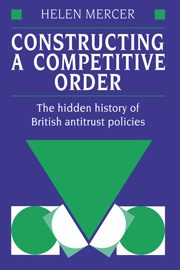Book contents
- Frontmatter
- Contents
- List of tables
- Acknowledgements
- Notes on conventions and abbreviations
- 1 Introduction
- 2 The British cartel system, 1880–1964
- 3 The state and the ‘monopoly problem’, 1880–1939
- 4 The war and the White Paper, 1940–44
- 5 The origins of the Monopolies and Restrictive Practices Act, 1948
- 6 Interpretation of policy – the Monopolies and Restrictive Practices Commission, 1949–56
- 7 The origins of the Restrictive Trade Practices Act 1956 – a re-interpretation
- 8 Resale price maintenance
- 9 Conclusions
- Appendixes
- 1 British participation in international cartels in manufactured goods, 1930s and 1950s
- 2 Correlation of RPM with levels of concentration of employment, 1938
- 3 The systematisation of British trade associations, 1875–1953
- 4 Analysis of the signatories of the ‘National Policy for Industry’, 1942
- 5 Criteria for the selection of references to the MRPC, 1949–56
- Notes
- Bibliography
- Index
5 - Criteria for the selection of references to the MRPC, 1949–56
Published online by Cambridge University Press: 29 January 2010
- Frontmatter
- Contents
- List of tables
- Acknowledgements
- Notes on conventions and abbreviations
- 1 Introduction
- 2 The British cartel system, 1880–1964
- 3 The state and the ‘monopoly problem’, 1880–1939
- 4 The war and the White Paper, 1940–44
- 5 The origins of the Monopolies and Restrictive Practices Act, 1948
- 6 Interpretation of policy – the Monopolies and Restrictive Practices Commission, 1949–56
- 7 The origins of the Restrictive Trade Practices Act 1956 – a re-interpretation
- 8 Resale price maintenance
- 9 Conclusions
- Appendixes
- 1 British participation in international cartels in manufactured goods, 1930s and 1950s
- 2 Correlation of RPM with levels of concentration of employment, 1938
- 3 The systematisation of British trade associations, 1875–1953
- 4 Analysis of the signatories of the ‘National Policy for Industry’, 1942
- 5 Criteria for the selection of references to the MRPC, 1949–56
- Notes
- Bibliography
- Index
Summary
In 1948 two Board of Trade memoranda outlined the basis for the selection of cases. One stated the principles on which the first four cases should be selected. These were:
where an independent body had recently recommended an enquiry;
a case of an international agreement which raised issues of public concern;
a ‘Co-operative’ case;
a case of monopoly buying.
The second, in a circular letter to Board of Trade production departments, urged the following criteria as bases for thinking about referral:
where there were reasons to think that efficiency could be improved;
where agreements adversely affected prices and the direction and volume of exports;
where complaints had been received;
where a decision was needed in other areas of policy, e.g. foreign exchange spending;
where a recent committee had disclosed restrictive practices;
where it was suspected that output was being restricted.
However, in its public report the Board of Trade explained that in 1949 items were chosen to get a range of types of restrictive practices and types of industries.
- Type
- Chapter
- Information
- Constructing a Competitive OrderThe Hidden History of British Antitrust Policies, pp. 196 - 197Publisher: Cambridge University PressPrint publication year: 1995



